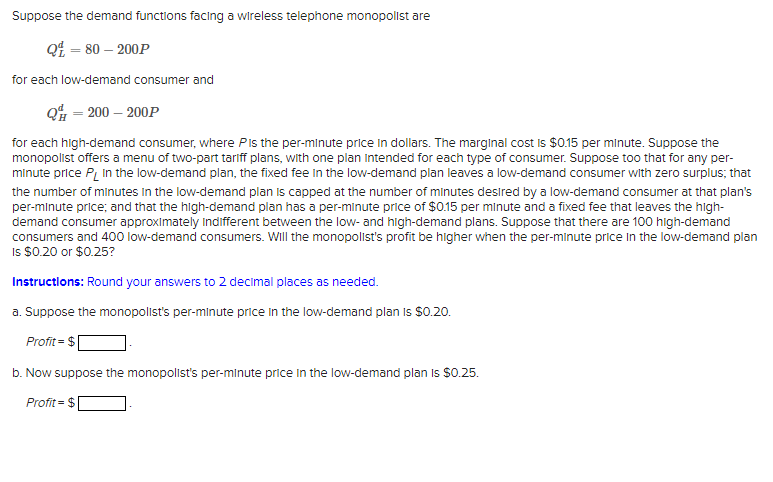Suppose the demand functions facing a wireless telephone monopolist are Q£ = 80 – 200P for each low-demand consumer and Q% = 200 – 200P for each high-demand consumer, where PIs the per-minute price in dollars. The marginal cost is $0.15 per minute. Suppose the monopolist offers a menu of two-part tariff plans, with one plan Intended for each type of consumer. Suppose too that for any per- minute price P, In the low-demand plan, the fixed fee in the low-demand plan leaves a low-demand consumer with zero surplus; that the number of minutes in the low-demand plan is capped at the number of minutes desired by a low-demand consumer at that plan's per-minute price; and that the high-demand plan has a per-minute price of $0.15 per minute and a fixed fee that leaves the high- demand consumer approximately Indifferent between the low- and high-demand plans. Suppose that there are 100 high-demand consumers and 400 low-demand consumers. Will the monopolist's profit be higher when the per-minute price In the low-demand plan Is $0.20 or $0.25? Instructlons: Round your answers to 2 decimal places as needed. a. Suppose the monopolist's per-minute price In the low-demand plan Is S0.20. Profit = $ b. Now suppose the monopolist's per-minute price In the low-demand plan is $0.25. Profit = $
Suppose the demand functions facing a wireless telephone monopolist are Q£ = 80 – 200P for each low-demand consumer and Q% = 200 – 200P for each high-demand consumer, where PIs the per-minute price in dollars. The marginal cost is $0.15 per minute. Suppose the monopolist offers a menu of two-part tariff plans, with one plan Intended for each type of consumer. Suppose too that for any per- minute price P, In the low-demand plan, the fixed fee in the low-demand plan leaves a low-demand consumer with zero surplus; that the number of minutes in the low-demand plan is capped at the number of minutes desired by a low-demand consumer at that plan's per-minute price; and that the high-demand plan has a per-minute price of $0.15 per minute and a fixed fee that leaves the high- demand consumer approximately Indifferent between the low- and high-demand plans. Suppose that there are 100 high-demand consumers and 400 low-demand consumers. Will the monopolist's profit be higher when the per-minute price In the low-demand plan Is $0.20 or $0.25? Instructlons: Round your answers to 2 decimal places as needed. a. Suppose the monopolist's per-minute price In the low-demand plan Is S0.20. Profit = $ b. Now suppose the monopolist's per-minute price In the low-demand plan is $0.25. Profit = $
MATLAB: An Introduction with Applications
6th Edition
ISBN:9781119256830
Author:Amos Gilat
Publisher:Amos Gilat
Chapter1: Starting With Matlab
Section: Chapter Questions
Problem 1P
Related questions
Question

Transcribed Image Text:Suppose the demand functions facing a wireless telephone monopolist are
Q£ = 80 – 200P
for each low-demand consumer and
Q% = 200 – 200P
for each high-demand consumer, where PIs the per-minute price in dollars. The marginal cost is $0.15 per minute. Suppose the
monopolist offers a menu of two-part tariff plans, with one plan Intended for each type of consumer. Suppose too that for any per-
minute price P, In the low-demand plan, the fixed fee in the low-demand plan leaves a low-demand consumer with zero surplus; that
the number of minutes in the low-demand plan is capped at the number of minutes desired by a low-demand consumer at that plan's
per-minute price; and that the high-demand plan has a per-minute price of $0.15 per minute and a fixed fee that leaves the high-
demand consumer approximately Indifferent between the low- and high-demand plans. Suppose that there are 100 high-demand
consumers and 400 low-demand consumers. Will the monopolist's profit be higher when the per-minute price In the low-demand plan
Is $0.20 or $0.25?
Instructlons: Round your answers to 2 decimal places as needed.
a. Suppose the monopolist's per-minute price In the low-demand plan Is S0.20.
Profit = $
b. Now suppose the monopolist's per-minute price In the low-demand plan Is S0.25.
Profit = $
Expert Solution
This question has been solved!
Explore an expertly crafted, step-by-step solution for a thorough understanding of key concepts.
Step by step
Solved in 2 steps with 1 images

Recommended textbooks for you

MATLAB: An Introduction with Applications
Statistics
ISBN:
9781119256830
Author:
Amos Gilat
Publisher:
John Wiley & Sons Inc

Probability and Statistics for Engineering and th…
Statistics
ISBN:
9781305251809
Author:
Jay L. Devore
Publisher:
Cengage Learning

Statistics for The Behavioral Sciences (MindTap C…
Statistics
ISBN:
9781305504912
Author:
Frederick J Gravetter, Larry B. Wallnau
Publisher:
Cengage Learning

MATLAB: An Introduction with Applications
Statistics
ISBN:
9781119256830
Author:
Amos Gilat
Publisher:
John Wiley & Sons Inc

Probability and Statistics for Engineering and th…
Statistics
ISBN:
9781305251809
Author:
Jay L. Devore
Publisher:
Cengage Learning

Statistics for The Behavioral Sciences (MindTap C…
Statistics
ISBN:
9781305504912
Author:
Frederick J Gravetter, Larry B. Wallnau
Publisher:
Cengage Learning

Elementary Statistics: Picturing the World (7th E…
Statistics
ISBN:
9780134683416
Author:
Ron Larson, Betsy Farber
Publisher:
PEARSON

The Basic Practice of Statistics
Statistics
ISBN:
9781319042578
Author:
David S. Moore, William I. Notz, Michael A. Fligner
Publisher:
W. H. Freeman

Introduction to the Practice of Statistics
Statistics
ISBN:
9781319013387
Author:
David S. Moore, George P. McCabe, Bruce A. Craig
Publisher:
W. H. Freeman